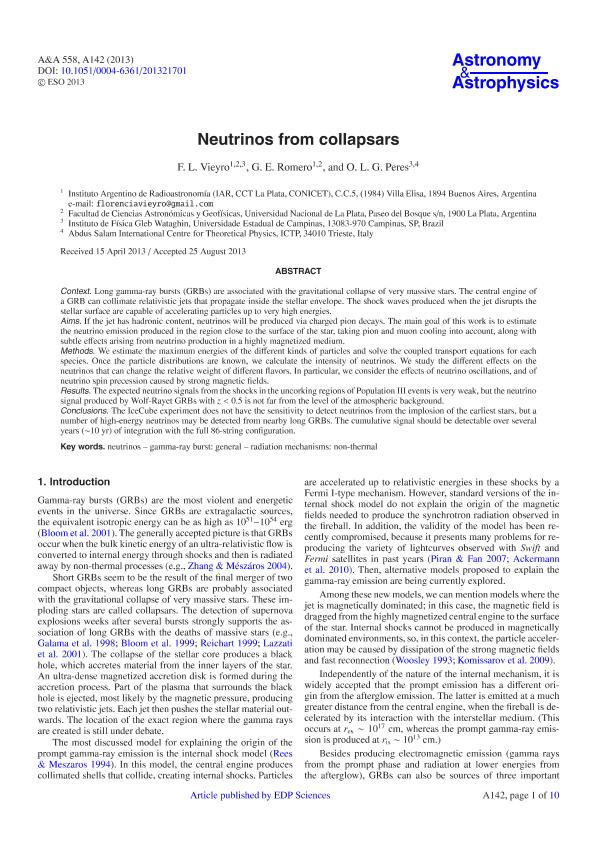Mostrar el registro sencillo del ítem
dc.contributor.author
Romero, Gustavo Esteban

dc.contributor.author
Peres, Orlando L. G.
dc.contributor.author
Vieyro, Florencia Laura

dc.date.available
2016-02-11T14:16:31Z
dc.date.issued
2013-10
dc.identifier.citation
Romero, Gustavo Esteban; Peres, Orlando L. G.; Vieyro, Florencia Laura; Neutrinos from collapsars; EDP Sciences; Astronomy and Astrophysics; 558; 10-2013; 1-10
dc.identifier.issn
0004-6361
dc.identifier.uri
http://hdl.handle.net/11336/4131
dc.description.abstract
Context. Long gamma-ray bursts (GRBs) are associated with the gravitational collapse of very massive stars. The central engine of a GRB can collimate relativistic jets that propagate inside the stellar envelope. The shock waves produced when the jet disrupts the stellar surface are capable of accelerating particles up to very high energies. Aims. If the jet has hadronic content, neutrinos will be produced via charged pion decays. The main goal of this work is to estimate the neutrino emission produced in the region close to the surface of the star, taking pion and muon cooling into account, along with subtle effects arising from neutrino production in a highly magnetized medium. Methods. We estimate the maximum energies of the different kinds of particles and solve the coupled transport equations for each species. Once the particle distributions are known, we calculate the intensity of neutrinos. We study the different effects on the neutrinos that can change the relative weight of different flavors. In particular, we consider the effects of neutrino oscillations, and of neutrino spin precession caused by strong magnetic fields. Results. The expected neutrino signals from the shocks in the uncorking regions of Population III events is very weak, but the neutrino signal produced by Wolf-Rayet GRBs with z < 0.5 is not far from the level of the atmospheric background. Conclusions. The IceCube experiment does not have the sensitivity to detect neutrinos from the implosion of the earliest stars, but a number of high-energy neutrinos may be detected from nearby long GRBs. The cumulative signal should be detectable over several years (~10 yr) of integration with the full 86-string configuration.
dc.format
application/pdf
dc.language.iso
eng
dc.publisher
EDP Sciences

dc.rights
info:eu-repo/semantics/openAccess
dc.rights.uri
https://creativecommons.org/licenses/by-nc-sa/2.5/ar/
dc.subject
GAMMA-RAY BURST: GENERAL
dc.subject
NEUTRINOS
dc.subject
RADIATION MECHANISMS: NON-THERMAL
dc.subject.classification
Astronomía

dc.subject.classification
Ciencias Físicas

dc.subject.classification
CIENCIAS NATURALES Y EXACTAS

dc.title
Neutrinos from collapsars
dc.type
info:eu-repo/semantics/article
dc.type
info:ar-repo/semantics/artículo
dc.type
info:eu-repo/semantics/publishedVersion
dc.date.updated
2016-03-30 10:35:44.97925-03
dc.journal.volume
558
dc.journal.pagination
1-10
dc.journal.pais
Francia

dc.journal.ciudad
Paris
dc.description.fil
Fil: Romero, Gustavo Esteban. Consejo Nacional de Investigaciones Científicas y Técnicas. Centro Científico Tecnológico - Conicet - la Plata. Instituto Argentino de Radioastronomia (i); Argentina
dc.description.fil
Fil: Peres, Orlando L. G.. Universidade Estadual de Campinas; Brasil
dc.description.fil
Fil: Vieyro, Florencia Laura. Consejo Nacional de Investigaciones Científicas y Técnicas. Centro Científico Tecnológico - Conicet - la Plata. Instituto Argentino de Radioastronomia (i); Argentina
dc.journal.title
Astronomy and Astrophysics

dc.relation.alternativeid
info:eu-repo/semantics/altIdentifier/arxiv/http://arxiv.org/abs/1309.6043
dc.relation.alternativeid
info:eu-repo/semantics/altIdentifier/doi/http://dx.doi.org/10.1051/0004-6361/201321701
dc.relation.alternativeid
info:eu-repo/semantics/altIdentifier/url/http://www.aanda.org/articles/aa/abs/2013/10/aa21701-13/aa21701-13.html
Archivos asociados
